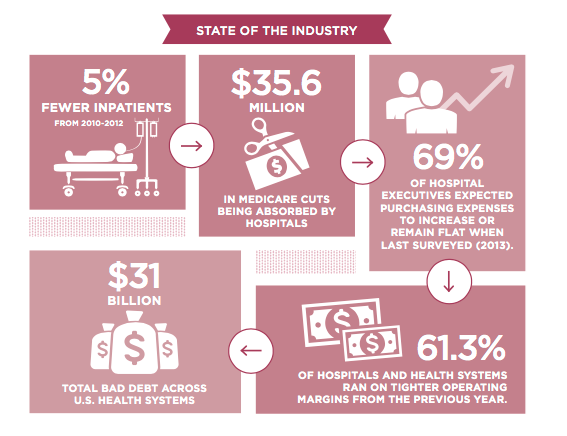Controlling costs is a big challenge for healthcare executives now more than ever. In this article we will illustrate the most obvious challenges and ways to rethink how to approach facilities management in order to contain costs and improve efficiency in your facility.
The State of the Industry? Challenging, as usual.
It’s conceivable there was a time when the world of healthcare had ample facility budgets, full patient beds and more than adequate reimbursements to cover government entitlement responsibilities. But that time is in the rearview mirror.
It’s no surprise to today’s healthcare executives that the state of the industry continues to be challenging in terms of controlling costs. Here are just a few illustrative developments:

In industries with less resilient executives, these figures would be seen as a sign of gloom and doom. But in the C-suites of healthcare executives, it’s more like business as usual. But that weary sense of familiarity doesn’t change the fact that it takes some real planning and business intelligence to meet your cost control challenges.
Know thyself—and thy spending
Experience has taught you that there are always, or usually, cost-saving opportunities available. The trick is to find them. Savings that are hidden are savings that are lost. That calls for a clear-eyed assessment of exactly what and where your spending occurs on all components touching your operation. The goal here is to clarify all costs, service contract terms and performance metrics throughout your facilities.
Often, that’s easier said than done, especially in facilities with decentralized, non-standard processes. For example, expenses may be spread out in various departments, and service contract expenses or time and materials could be missing from your records altogether.
Are you relying too much on outside resources?
A thorough current state assessment can finally answer that nagging question: Do you have the resources to do what needs to be done in your facility, or are you dependent on external service contracts? To be a little more blunt, is your department handling what needs to be done or just managing contractors?
That can be an expensive answer when you consider the cost difference can be roughly double when you have to pay a contractor rather than a highly skilled full-time employee.
Let’s break it down: Two hospitals need a boiler repair. Hospital A calls their easily accessible, on-site associate who makes approximately $80,000 per year. Hospital B doesn’t have access to a technical FTE, so they have to pay approximately $160,000 for an annual contract to handle the same work—with the added risk of a repair downtime due to the contractor’s availability.
InSourcing: A better way to save
A growing number of healthcare facility leaders are opting for a new kind of in-house model that gives them a measure of self-sufficiency, which brings talent back into the facility vs. contractor headaches.
Medxcel Facilities Management takes a unique approach to the Insourcing model that brings the expertise to the administration side. It benefits facilities by reducing cost and providing better service. Medxcel Facilities Management has a unique and state-of-the-art InSourcing model that brings the expertise to the administration. It benefits healthcare facilities by reducing cost and providing better service. A vast array of services falls under the Medxcel Facilities Management catalogue, including facilities management, emergency management, safety, environment of care, project management and construction.
In addition to delivering proven systems, deep data, and essential expertise, Medxcel Facilities Management also shoulders much of the accountability for your program’s ROI. We partner in that capacity with hundreds of healthcare facilities, having documented their ability to reap long-term value while multiplying their internal resources and capabilities.
The bottom line -- InSourcing brings value by allowing you to attract and retain top talent. You get a better outcome, you get better response times; and overall your cost reduces.